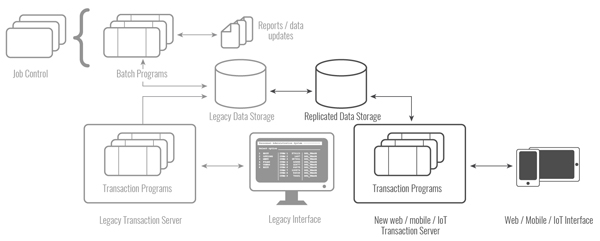New Online Processing and Data Storage
Last time, we looked at a new online processing solution that would replace the existing online processing, but leverage all other parts of the legacy infrastructure. In this post, we’ll take a close look at a similar solution that also leverages some of what exists, but creates all new online processing as well as new database components.
The New Online Processing and Data Storage solution is a database integration / parallel transaction processing framework. Legacy interfaces interact with existing transaction programs running on a legacy transaction server as before. In a parallel but separate environment, web / mobile interfaces interact with completely new transaction processing on a new business logic server.

To the original mainframe configuration in Part 1, we have added three new components. This image shows a new (replicated) database, and a new business logic server running servlets and/or widgets that service a completely new set of new web / mobile interfaces. Here is a summary of what the environment looks like in this scenario:
- The Legacy Data Storage (Db2, IMS, VSAM, IDMS, QSAM, Oracle, etc.) – This will remain unchanged from before
- Multiple Programs that are linked together with JCL that define the batch jobs that process the data – This will also remain unchanged
- Multiple Transaction Programs that are managed and sequenced by the online processing environment, Transaction Server (CICS, IMS-TS, etc.) – This will also remain unchanged
- New Servlets / Widgets that are managed and sequenced by the new business logic server and associated interfaces
- New (Replicated Data Storage) that is kept in sync with the legacy data storage
Benefits of New Online Processing and Data Storage
- Many business logic server options are available, although they are often part of a web server such as WebSphere, WebLogic, Apache, JBoss, etc.
- The existing mainframe application should be able to function relatively independently without significant impact.
- It can grow over time, delivering only the functionality that is needed immediately for web / mobile with more functionality added as required, even eventually replacing the legacy transaction server if that is a viable goal.
- If web / mobile infrastructures have different workload characteristics they can be leveraged by the new platform, with less impact on the existing infrastructure.
Drawbacks of New Online Processing and Data Storage
- The need to recreate functions that are likely already available in the legacy transaction server will duplicate function.
- Possible dual code path complicates support and future enhancements.
- The need to understand the existing functions of the online processing environment (where similar functions need to be on the new online processing environment) with few tools, and nothing comprehensive enough for a solution.
Development Details
Building what amounts to essentially new purpose-built applications and a dedicated data store will leverage only parts of the existing legacy assets. This approach will still leverage the existing investment in code (at least initially) and provide the rich experience needed for mobile and web users. This scenario often exists where there is an urgent need to deliver a web / mobile solution, but without having the tools or forethought to deliver a more efficient option.
This solution requires a method that will replicate data between the old and new, so that they are able to share and update the same data. A flexible data replication solution that replicates changed data only is essential, but schemas do not need to be the same. The new database could evolve over time to completely replace the existing online processing environment, if that were the goal.
A purpose-built application and dedicated data store approach may be required where an organization has merged with, or acquired one or more other organizations.